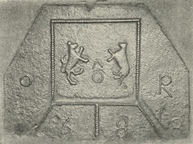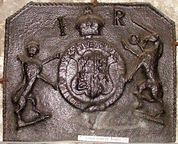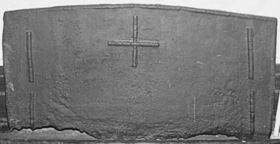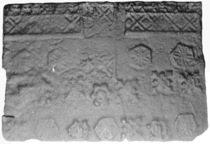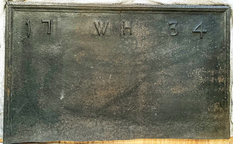-
897
Description: Steeply canted rectangle; no edging; upper centre, square formed of twisted rope lengths inside which are what appear to be two lions passant in pale with a circle and two short sloping lines in inverted V form above; on either side of the square is an O and an R; below the square three lengths of twisted rope extend to the bottom edge, the central one vertically and the the outer two sloping away from the centre; along the bottom is the date, each numeral separated by one of the rope lengths.
Notes: Alleged to be a representation of the arms of the O'Rourke family, who held sway in Cavan and Leitrim, the initials said to be of Owen O'Rourke. Noted in a cottage at Arigna, County Roscommon.
Inscription: O O R / 1 6 8 8
Arms: O'Rourke
- Decoration tags:
- canted rectangular (shape)
- none (edging)
- simple stamps
- carved stamps
- heraldic
- text
- animals
- objects
Manufactured: in 1688 possibly at Drumshanbo Furnace in the Leitrim area of Ireland.
Current location: not known.
Citation: Lindsay, J. S., 1927, Iron & Brass Implements of the English House (London, The Medici Society).
- Attached to series:
- Miscellaneous stamp firebacks
- Date & initials firebacks
-
204
Description: Canted rectangle; twisted rope edging (top and sides); Tudor royal shield and Garter with crown above, between lion and unicorn supporters; initials separated by crown; a small ring and bar are placed to the left of the unicorn’s mouth.
Notes: The Tudor shield and crown feature on many Wealden firebacks, and have here been reused with Jacobean supporters; their stamps are derived from standing models.
Inscription: I R
Arms: Tudor royal
- Decoration tags:
- canted rectangular (shape)
- rope (edging)
- carved stamps
- individual letters
- heraldic
- armorial
- royal
Manufactured: in the early 17th century possibly at Pounsley Furnace, Framfield in the Weald area of England.
Current location: St Mary's Abbey, Blanchland, Northumberland, England.
- Attached to series:
- Pounsley series
- Jacobean royal armorial firebacks
-
114
Description: Quasi-rectangular shape with low-curved convex top; edging (top and sides)formed of lengths of dowel grooved laterally and helically; upper centre, cross formed of the same dowel; at each side, tandem arrangement of longer dowel, similarly grooved.
Notes: The base board appears to be the same size and shape as that of a fireback at Plaxtol, Kent (no. 587), which also has the same edging; and the grooved dowels are also on a fireback with dagger stamps at Lewes; the cross will have been intended to have apotropaic significance. Formerly part of the Ade Collection (from Grove Hill, Hellingly, Sussex).
- Decoration tags:
- quasi-rectangular (shape)
- grooved dowel (edging)
- simple stamps
- apotropaic
- objects
Manufactured: in the mid to late 16th century in the Weald area of England.
Current location: Hastings Museum and Art Gallery, John's Place, Bohemia Road, Hastings, East Sussex, England.
Museum number: HASMG: 1952.51.21 (part of the Hastings Museum museum group)
- Attached to series:
- Grooved dowel series
-
152
Description: Rectangular; plain plate; on top, twice repeated stamp probably formed of a section of cresting with a row of seven ?fleurs-de-lys above a diagonal grid of squares, each with a small raised square in the middle, and a horizontal astragal border below; between the cresting, a stamp of indeterminate form and design; below, four repeated hexagonal stamps, each divided into triangles by raised lines, two under each cresting stamp; between them, a stamp of indeterminate form and design, possibly the same as the one above it; below, probably six double crosses flory, with a flower head stamp between each group of three; along the bottom, two crosses flory, three hexagon stamps and two other stamps of indeterminate form and design (though different from those described above), arranged asymetrically.
Notes: A crude and poorly executed casting. Butterfield (1916) illustrated this fireback the other way up, and that is how it was displayed in Hastings Museum when it was photographed in the early 2000s. The orientation of this fireback has been reconsidered and the greater relative wear and heat corrosion of the smaller individual stamps suggests that the cresting was originally at the top of the fireback and not the bottom.
- Decoration tags:
- rectangular (shape)
- none (edging)
- carved stamps
- objects
Manufactured: in the mid 16th century in the Weald area of England.
Current location: Hastings Museum and Art Gallery, John's Place, Bohemia Road, Hastings, East Sussex, England.
Museum number: HASMG: 1911.60.8 (part of the Hastings Museum museum group)
Citation: Butterfield, W. R., 1916, 'Old Wealden Firebacks', The Connoisseur, 46, pp. 197-209.
- Attached to series:
- Miscellaneous stamp firebacks
-
1236
Description: Rectangular; ogee moulding on top and side edges; symmetrical layout of date and initials; date split between left and right sides, initials in middle.
Notes: One of a series of backs dating to the 1730s and 40s using very similar sets of letters and numerals. Formerly at Yeomans, Mayfield, Sussex.
Inscription: 17 / WH / 34
- Decoration tags:
- rectangular (shape)
- cyma reversa/ogee (edging)
- carved stamps
- individual letters
- individual numbers
- text
Manufactured: in 1734 in the Weald area of England.
Current location: not known.
- Attached to series:
- 1730s-40s, date & initial series
- Date & initials firebacks
